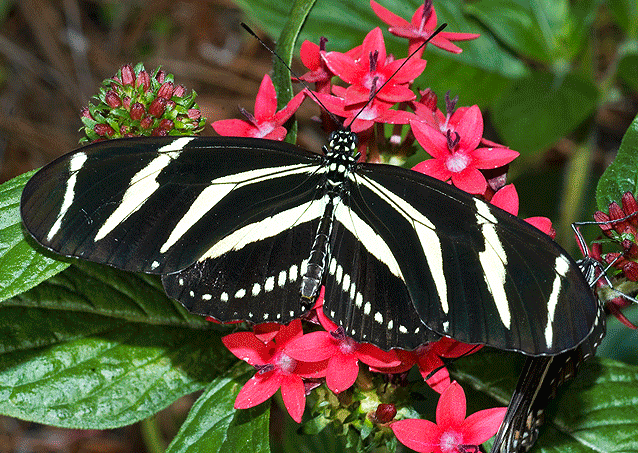Zebra Heliconia / Zebra Longwing
Heliconius charitonius
Zebra Heliconia / Zebra Longwing
Heliconius charitonius
Photographs by Susan Leach Snyder
A mother zebra heliconia lays her eggs singly on the tender stem tips and leaves of passion vine. The eggs are very small, yellow, and cylindrical with beaded surfaces.
She may lay up to 1000 eggs; however, because of predation, disease and other natural causes, many do not make it to the adult stage. As shown below, spiders are one of the predators.
The eggs hatch into tiny yellow caterpillars. The penny below shows the scale of the eggs and newly-hatched caterpillars.
After hatching, caterpillars are voracious eaters. Below are caterpillars eating corky-stem passion vine. Note the difference in size of these individuals. As they grow, each caterpillar will molt five times before it pupates (forms a chrysalis). The smallest caterpillar in the picture on the left is a new hatchling, while the larger is getting ready to molt into a chrysalis. The photograph on the right shows several larval stages.
Below, a close-up shows a caterpillar feeding. The head is on the left. The spines are not venomous, but they would probably ward off some predators.
When a caterpillar is ready to pupate, it crawls to a surface where it can hang. It deposits silk at its posterior end and hangs for about a day, as shown below on the left. Then it quickly begins its transformation into a chrysalis. This transformation takes about a minute. In the middle picture below, the skin just behind the head has split. In the picture on the right, the caterpillar's skin is pushed up and the chrysalis begins emerging.
Below: The chrysalis continues to emerge. It wriggles out of the caterpillar skin, which eventually falls to the ground. In the right picture below, the chrysalis skin hardens and it remains that way for almost two weeks. During that time, the chrysalis cannot feed. Inside its skin, it is transforming into an adult.
About 12 days later, the chrysalis becomes transparent and the adult butterfly ecloses (emerges). When the adult ecloses, its wings are folded.
In the last photograph above and in far left photograph, the butterfly is unfolding its wings by pumping blood into its wing veins. After filling its wing veins with blood, it excretes excess wastes from its abdomen.
Once the wings are fully extended and dry, it's ready to fly, and forage for food.
The picture below shows a butterfly that has flown to pentas to feed.

Zebra heliconia butterflies belong to a group called the brush-footed butterflies. Although they have three pairs of legs like all other butterflies, their first pair of legs are modified into brushes which have taste sensors that help the female identify plants on which to lay eggs. The photo at left shows some of the structures of a zebra heliconia's head and thorax: Head: 1-antenna, 2-compound eye, 3-proboscis; Abdomen: 4-modified first pair of legs, 5-second pair of legs, 6-third pair of legs.
At right is a close-up photo of the side of a butterfly's head. Notice the facets of the eye. Butterflies can see both visible light and ultraviolet light. They see designs and colors in flowers that we cannot see.
Once a butterfly spots a good nectar source, it lands on the flower, uncurls its proboscis, places it into the tubular pistil of a flower, and begins sucking up nectar. An unusual thing about a zebra heliconia is that when it places its proboscis into the pistil, pollen from the flower's stamens sticks to the outside of the proboscis. A zebra heliconia produces an enzyme that is expelled from the tip of its proboscis and digests the pollen. The digested pollen is then sucked up the proboscis. The amino acids in the digested pollen give the butterfly extra food/energy for producing reproductive materials and for living longer than most butterflies. Most other butterflies live only a few weeks as adults; zebra heliconia can live up to six months.
After emerging from the chrysalis, an adult does not wait long to mate. In fact, the scent of a female butterfly can be detected while she is still inside a chrysalis, as shown in the photograph at left. It is not uncommon to see males flittering around a chrysalis waiting to be the first to mate.
The female on the left in this photograph was released back to the garden after being raised from an egg by the photographer. It was mating within a few minutes of the release. Note that the male has tattered wings.
At night, zebra heliconia cluster on a tree branch. It is thought this is a way of defending themselves from predators. Each butterfly produces a pheromone (scent). In large groups, the smell can be very strong. There can be up to 60 individuals in a cluster.
The favorite habitat of the zebra heliconia is a tropical hammock in the southern parts of Florida. This butterfly is the most frequent visitor to the Lagoon Trail gardens. The zebra heliconia was recognized as Florida's state butterfly in 1996.
___________________________________
Links:
Index to Butterfly and Moth Visitors to the Conservancy Ecotone Trail
Index To Photographs of Plants in the Gardens
Conservancy of Southwest Florida Ecotone Home Page
Conservancy of Southwest Florida Home Page.
Please report errors to Susan Snyder at susanleachsnyder@gmail.com